Physical Address
304 North Cardinal St.
Dorchester Center, MA 02124
| Condition | Site of involvement | Discriminatory findings |
|---|---|---|
| Primary osteoarthritis (F>M ▸ > 45 years) | Hands | PIP and DIP joint involvement (Heberden's and Bouchard's nodes) ▸ no osteopenia |
| Large joints (e.g. hip, knee) | Joint space narrowing ▸ subchondral sclerosis ▸ subchondral cysts ▸ marginal osteophytes | |
| Spine | Degenerative disc disease ▸ spondylosis deformans ▸ apophyseal joint involvement ▸ spinal stenosis ▸ foraminal stenosis | |
| Erosive osteoarthritis (affects middle-aged females) | Hands | PIP and DIP joint involvement ▸ joint ankylosis ▸ ‘gull-wing’ deformities (central erosions and marginal osteophytes) |
| Rheumatoid arthritis (F>M ▸ Rh factor positive) | Hand and wrist | Symmetrical arthritis ▸ MCP and PIP joint involvement ▸ periarticular (early) and diffuse (late) osteopenia ▸ marginal erosions ▸ subluxation (swan neck and boutonnière deformities) ▸ periostitis is uncommon |
| Large joints | Joint space narrowing ▸ marginal erosions ▸ synovial cysts ▸ protrusio acetabulae | |
| Spine | Atlantoaxial subluxation | |
| Juvenile idiopathic arthritis (M = F ▸ affects children) | Hands | Joint ankylosis ▸ florid periosteal reaction ▸ osteopenia |
| Large joints (e.g. knee) | Abnormalities of growth and maturation ▸ epiphyseal overgrowth and premature closure of the physis ▸ widened intercondylar notch | |
| Cervical spine | Apophyseal joint fusion ▸ atlantoaxial subluxation | |
| Psoriatic arthritis (M>F ▸ nail changes ▸ HLA-B27 +ve) | Upper extremities (e.g. hands and feet) | ‘Sausage’ digit ▸ DIP joint involvement ▸ terminal tuft erosion ▸ pencil-in-cup deformity ▸ joint ankylosis ▸ arthritis mutilans ▸ periosteal reaction ▸ no osteopenia |
| SI joints | Asymmetric or unilateral sacroiliitis | |
| Spine | Coarse syndesmophytes | |
| Reiter's syndrome (affects young male adults) | Lower extremities (e.g. foot) | Hallux involvement ▸ periosteal reaction ▸ calcaneal erosions ▸ osteopenia not prominent |
| Spine | Coarse syndesmophytes | |
| SI joints | Asymmetric or unilateral sacroiliitis | |
| Ankylosing spondylitis (M>F ▸ affects young adults ▸ HLA-B27 +ve in 95%) | SI joints | Bilateral symmetrical sacroiliitis ▸ ankylosis |
| Spine | Anterior vertebral body squaring ▸ syndesmophytes ▸ paravertebral ossification ▸ bamboo spine | |
| Pelvis | ‘Whiskering’ of the iliac crests and ischial tuberosities | |
| Enteropathic arthropathies | SI joints | Symmetrical sacroiliitis |
| Gout (M>F) | Hands and feet (especially the great toe) | MTP joint of the great toe ▸ juxta-articular erosions ▸ punched-out lesions with an overhanging margin ▸ no periarticular osteopenia ▸ tophi |
| CPPD crystal deposition disease (M = F) | Any peripheral joint ▸ predilection for the knee | Degenerative changes ▸ chondrocalcinosis ▸ paucity of subchondral sclerosis |
| HA crystal deposition disease (M = F) | Predilection for the shoulder (supraspinatus tendon) | Periarticular calcification |
| Haemochromatosis (M>F) | Hands | 2 nd and 3 rd MCP joint involvement (‘squared’ metacarpal heads) ▸ joint space narrowing ▸ ‘hook-like’ osteophytes ▸ numerous subchondral cysts |
| Alkaptonuria (ochronosis) (M = F) | Intervertebral discs ▸ SI joints ▸ large joints | Degenerative changes: disc calcification ▸ joint space narrowing ▸ periarticular sclerosis |
| Systemic lupus erythematosus (F>M ▸ affects young adults) | Hands | Reversible MCP joint subluxation |
| Scleroderma (F>M ▸ affects adults) | Hands | IP joint arthritis ▸ acro-osteolysis ▸ soft tissue calcifications |
| Mixed connective tissue disease (overlap syndrome) | Hands | PIP joint, MCP joint, mid-carpal involvement ▸ soft tissue swelling, calcifications or atrophy |
| Multicentric reticulohistiocytosis (F>M) | Hands and feet | DIP joint and carpal involvement ▸ soft tissue swelling ▸ articular erosions ▸ no osteopenia |
| Polymyositis / dermatomyositis | Proximal extremities | Soft tissue calcification |
| Hands | DIP joint erosions | |
| Sarcoidosis | Distal and middle phalanges of the hands and feet | Punched-out cyst-like lesions ▸ ‘lace-like’ appearance |
| Haemophilic arthropathy (affecting males – but with female carriers) | Predilection for large joints (e.g. knee) | Epiphyseal overgrowth ▸ juxta-articular osteopenia ▸ erosion and cartilage destruction ▸ widened intercondylar and trochlear notches ▸ squared patella |
| Neuropathic arthropathy | Any joint | 5 ‘D's’: normal bone D ensity ▸ joint D istension ▸ bony D ebris ▸ joint D isorganization ▸ D islocation |
| Hypertrophic osteoarthropathy | Tubular bones (radius and ulna > tibia and fibula) | Diaphyseal and metaphyseal painful periostitis |
This is the most common joint disorder – it is a balance between degenerative joint destruction (stressed bone) and repair (non-stressed bone)
Primary OA: there is no underlying cause ▸ it occurs in the context of normal biomechanical forces
The joints most at risk: thumb base ▸ DIP joints ▸ acromioclavicular joints ▸ knees ▸ hips ▸ 1 st MTP joints ▸ spinal apophyseal joints
Secondary OA: joints are damaged by previous disease
Causes : trauma ▸ systemic, metabolic or endocrine disorders (e.g. rheumatoid arthritis, ochronosis, haemochromatosis) ▸ crystal deposition disease ▸ neuropathic disorders ▸ congenital hip dislocation ▸ bone dysplasias
Pain ▸ reduced movement ▸ joint crepitus (± effusion) ▸ early morning stiffness
It is typically asymmetrical and affects the hands, spine and large weight-bearing joints ▸ primary and secondary OA have similar radiological appearances
Localized joint space narrowing ▸ subchondral cysts and sclerosis ▸ marginal osteophytes ▸ loose bodies ▸ chondocalcinosis
Deformity and subluxation are uncommon ▸ osteoporosis and ankylosis are not features
The commonly affected joints: 1 st MCP joint, scaphotriquetral joint, IP joints ▸ distal and proximal IP joint prominences are commonly seen (Heberden's and Bouchard's nodes, respectively)
Tibial spine spiking is an early sign ▸ the medial joint compartment shows the greatest narrowing (as it is subject to greater stressors) leading to a varus deformity ▸ it usually affects the lateral facet of patellofemoral joint ▸ there is articular and meniscal cartilage chondrocalcinosis
Chondromalacia patellae: this is a related condition in younger patients with softening of the patellar cartilage (due to repetitive trauma)
Pellegrini–Stieda disease: ossification of the medial collateral ligament is associated with degenerative change or may occur in isolation
Loss of the superior weight-bearing joint space with marginal osteophytes, subchondral acetabular cysts (Egger's cyst) and sclerosis formation ▸ there is a tendency for superolateral femoral head subluxation (but there may be lateral restraining osteophytes) ▸ rarely medial migration can lead to protrusio acetabuli ▸ ‘buttressing’: osseous hypertrophy along the medial femoral neck
The 1st MTP joint is the most commonly affected site (and is associated with hallux valgus)
‘Talar beak’: the talonavicular joint is also commonly involved with formation of a dorsal bone spur
See degenerative spinal disease Section 7 Chapter 6
This characteristically affects middle-aged women ▸ destructive changes outstrip productive changes and can mimic an erosive arthritis (such as psoriatic arthropathy)
Central erosions and marginal osteophytes (a ‘gull wing’ pattern) affecting the PIP + DIP joints (although large joint involvement has been described)
Differential: psoriasis and rheumatoid arthritis – however these will have no 1 st CMC joint involvement and will have marginal (as opposed to central) erosions with no true osteophyte formation
| Radiological finding | Pathological cause |
|---|---|
| Localized joint space narrowing | Articular cartilage fibrillation, ulceration and erosion lead to changes in collagen and protein polysaccharide structure of cartilage. This results in reduced turgor |
| Subchondral bony sclerosis | Increased osteoblastic activity resulting in new bone formation and increased cellularity of the subchondral bone |
| Osteophyte formation (most commonly marginal) | Cartilage and bone proliferation and revascularization of remaining cartilage |
| Bone cysts and bone collapse | Subchondral micro-fractures and passage of synovial fluid under pressure through the damaged cartilage to excavate a subchondral cyst |
| Gross deformity with subluxation | Ligamentous laxity resulting from mechanical force applied after the distortion of capsular structures |
| Loose bodies | Fragments of bone and cartilage become separated and, if not resorbed, become loose in the joint. They may reattach to the membrane, become vascularized and undergo endochondral ossification |
| Fibrocartilage or hyaline cartilage calcification | This is usually due to calcium pyrophosphate deposition disease (CPPD). The reparative response is usually quite florid |
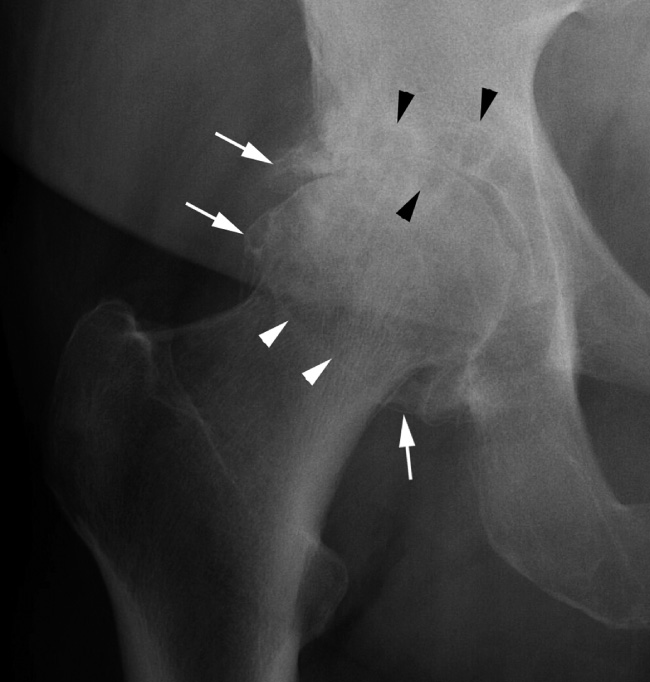
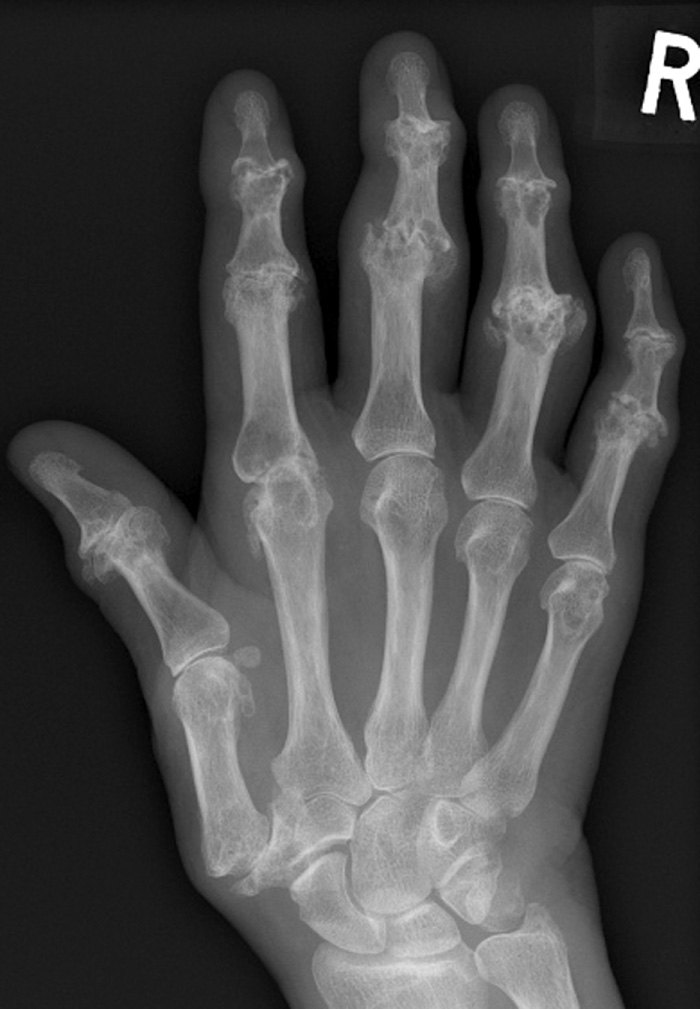
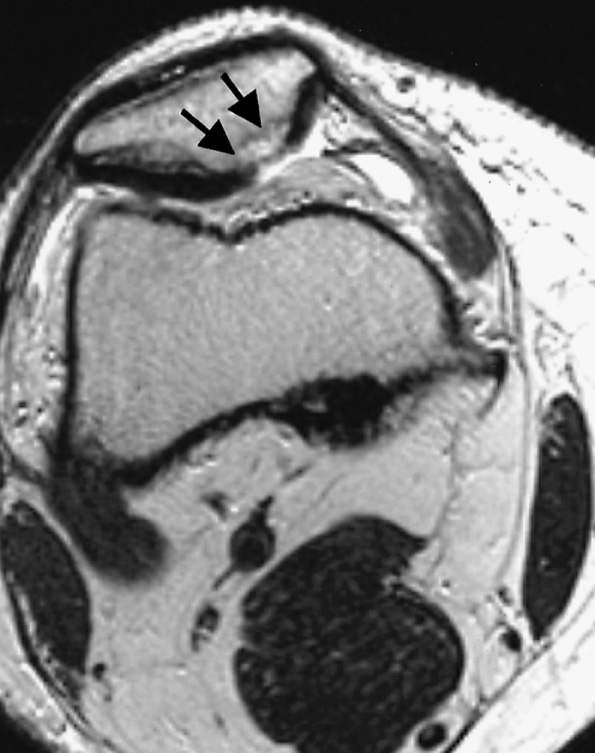
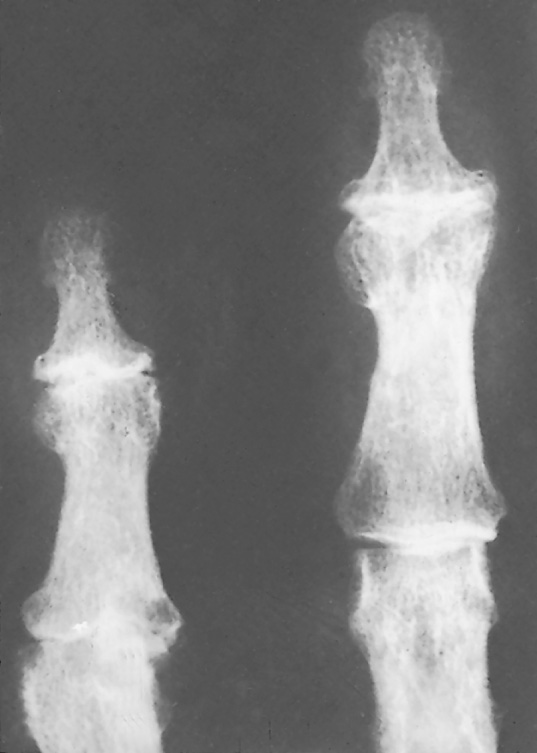
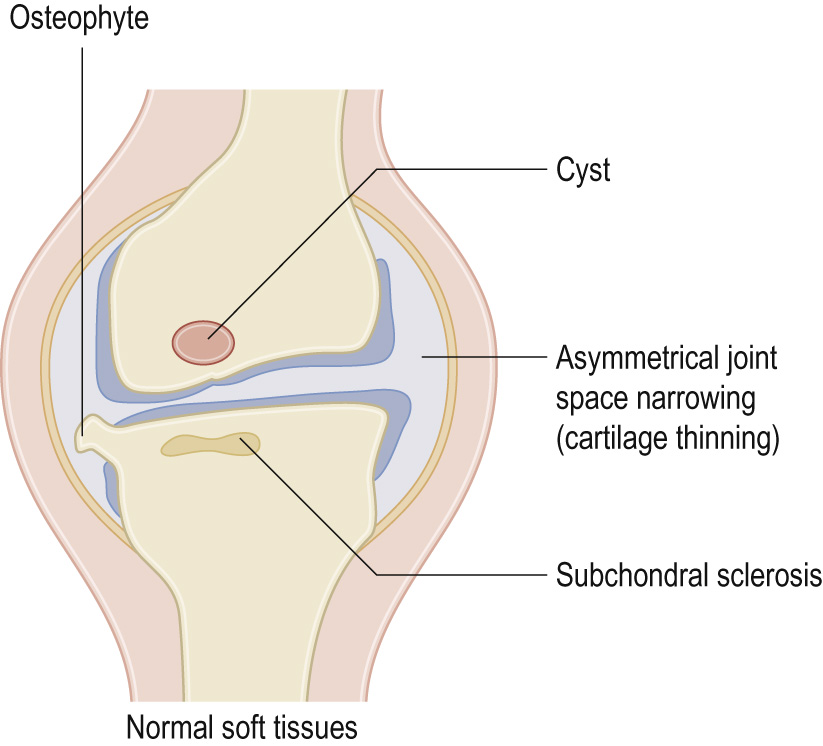
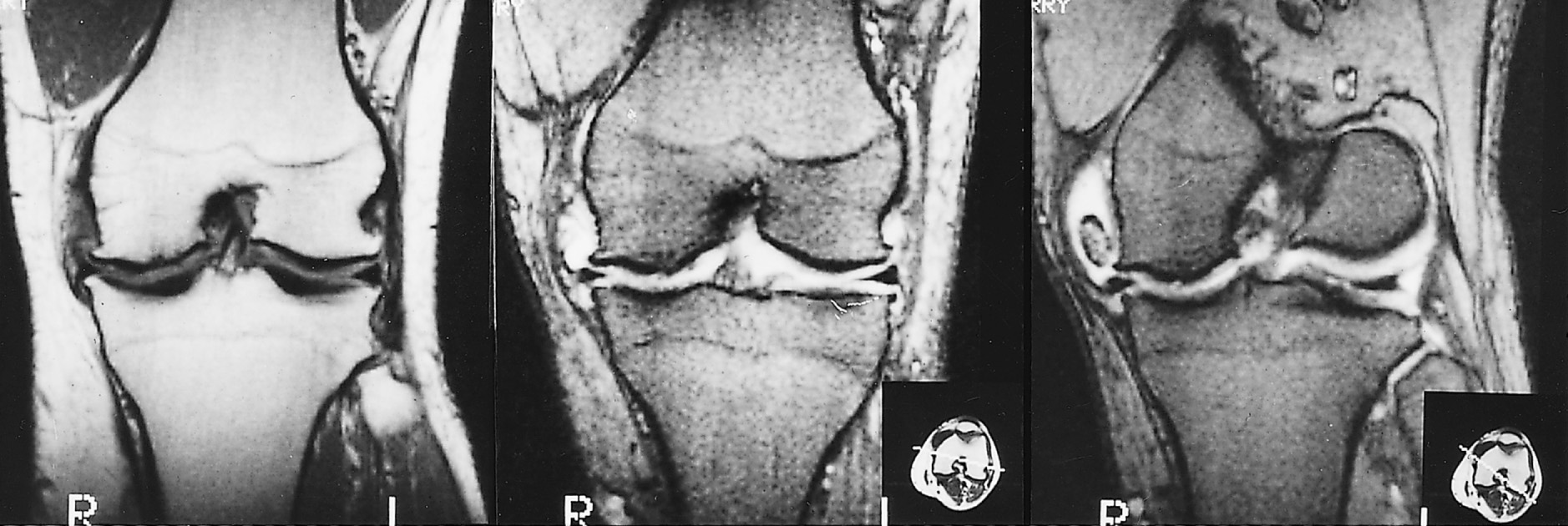
There is recurrent bleeding into a joint due to a deficiency of blood clotting factors ▸ the repeated intra-articular bleeding leads to villous synovial hypertrophy with the accumulation of haemosiderin within macrophages ▸ with recurrent bleeds there is no longer complete recovery (restricted joint motion/contractures/muscle atrophy)
Classic haemophilia (haemophilia A): X-linked recessive ▸ factor VIII deficiency
Christmas disease (haemophilia B): X-linked recessive ▸ factor IX deficiency
Painful and swollen joints ▸ joint deformities
It is only expressed in males (females can be carriers)
It particularly affects the knee, elbow, ankle and shoulder ▸ small peripheral joints are rarely involved
Hyperaemia causes epiphyseal overgrowth and accelerated maturation in the immature skeleton ▸ pannus similar to that in rheumatoid arthritis causes marginal erosions ▸ there is neither uniform nor symmetrical joint involvement
Acute: joint effusion and oedema
Chronic: juxta-articular osteoporosis resulting from haemorrhage and periarticular hyperaemia ▸ increased radio-opacity of the periarticular soft tissues and synovium (due to haemosiderin deposition) ▸ articular erosion and cartilage destruction (due to a thickened synovium) ▸ secondary osteoarthritis (subchondral cysts are common)
Knee: a widened intercondylar notch ▸ a squared patella ▸ enlarged femoral condyles ▸ it demonstrates similar appearances to juvenile rheumatoid arthritis
Elbow: an enlarged radial head, erosion of the trochlear notch and olecranon fossa
Hip osteonecrosis ▸ protrusio acetabuli ▸ slipped epiphysis ▸ coxa valga
5 stages:
Stage I: soft tissue swelling (± joint effusion) ▸ normal joint surfaces
Stage II: stage I + periarticular osteoporosis ▸ epiphyseal overgrowth
Stage III: erosions, sclerosis and subchondral cysts ▸ the joint space is preserved
Stage IV: stage III + focal or diffuse joint space narrowing
Stage V: a stiff contracted joint with significant degenerative change
This can detect early synovial thickening and hypervascularity, and cartilaginous changes ▸ it can differentiate between acute and chronic soft tissue bleeding
T1WI/T2WI: a thickened and irregular synovium with fibrosis and haemosiderin deposition
Haemosiderin: this generates low SI foci, with a blooming artefact on gradient-echo (GE) sequences
Septic arthritis is a rare complication of haemophilia
These can develop following the encapsulation of episodes of repeated haemorrhage ▸ it occurs particularly within the femur and around the pelvis ▸ it presents as a painless expanding mass, with soft tissue and bone destruction ▸ can be calcified ▸ mural nodules are characteristic
T1WI: a low SI thick fibrous capsule ▸ T2WI: central high SI (due to blood breakdown products)
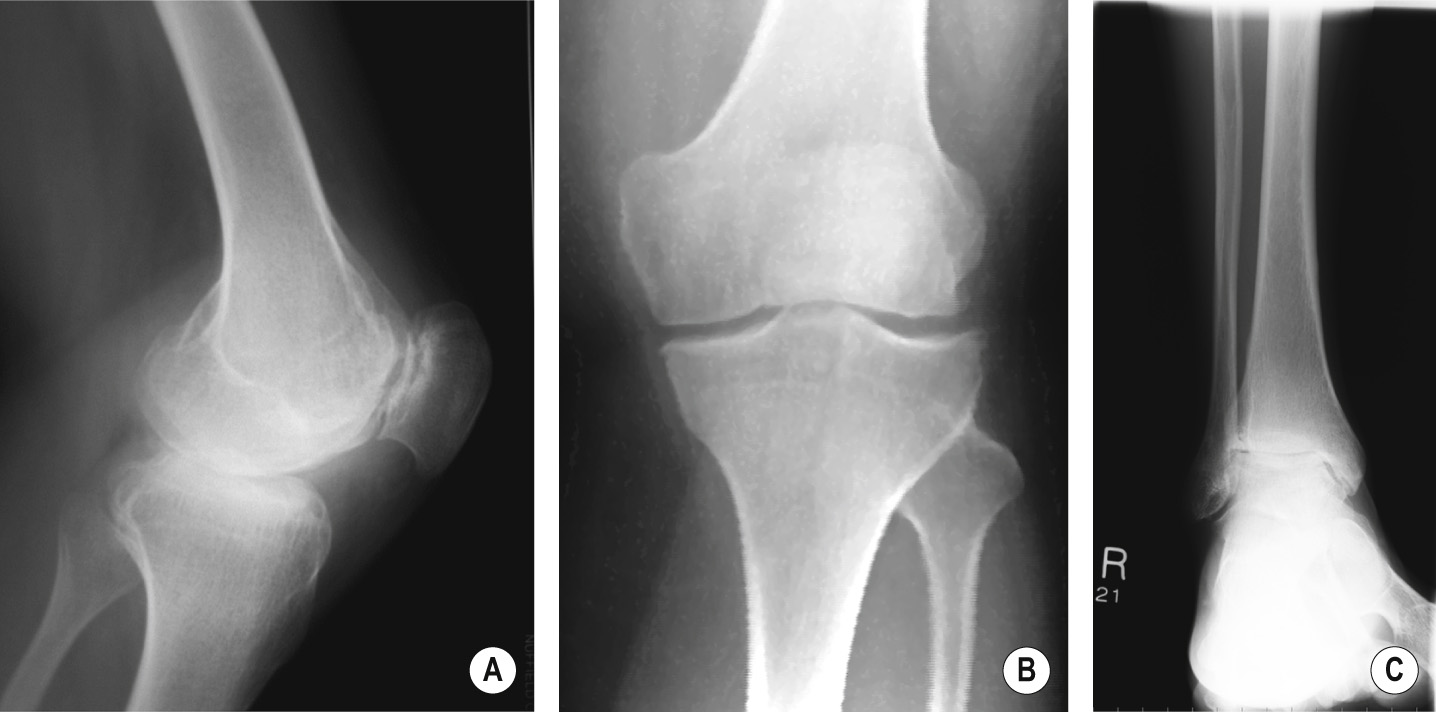
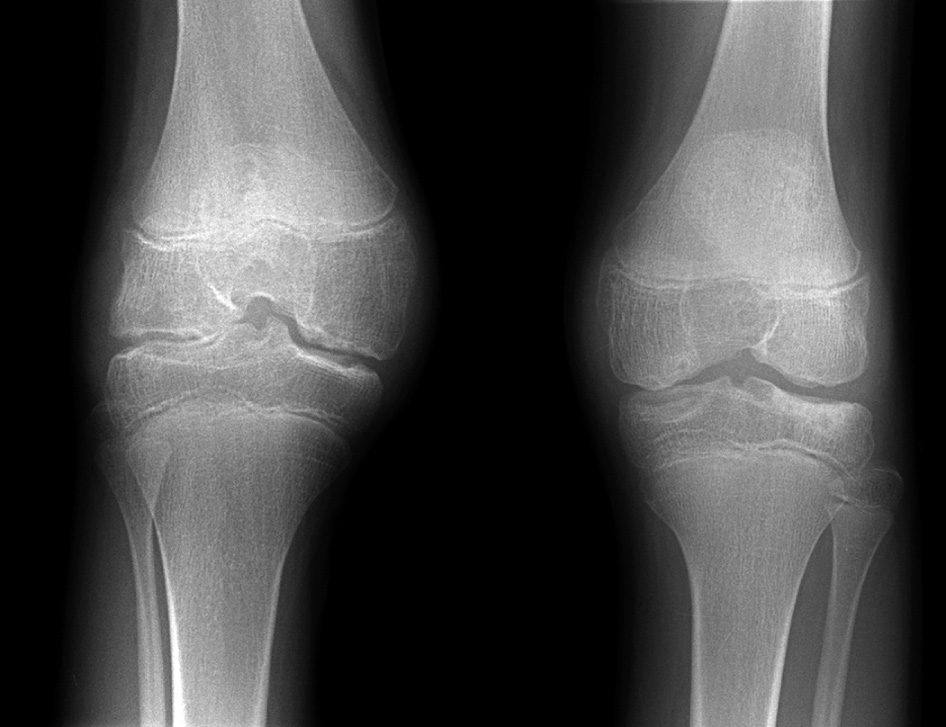
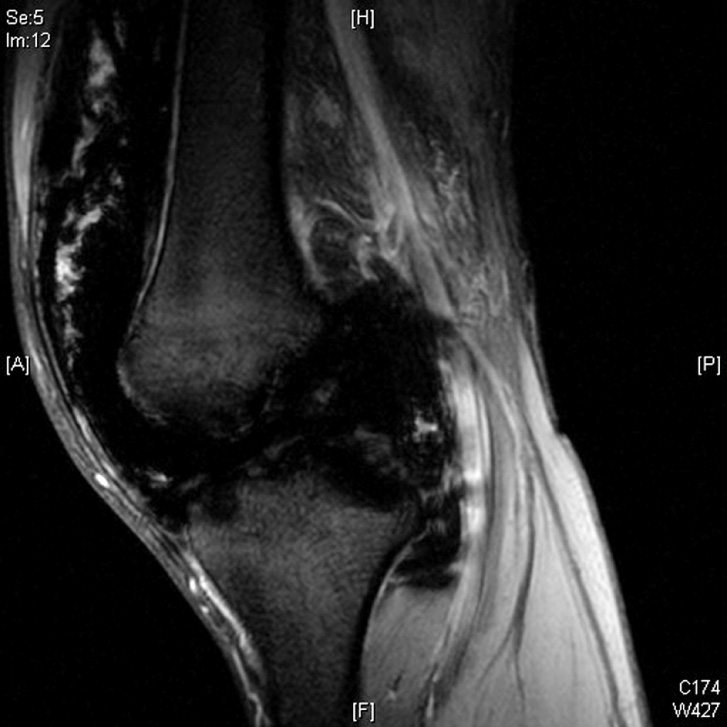
A destructive and productive articular abnormality following a loss of pain sensation and/or proprioception
Painless joint deformity and destruction on a background of neurological disease
The distribution helps determine the cause (see table)
This occurs early and is more acute ▸ resorption of the ends of affected bones results in sharp pointed ends ▸ there is an absence of osteoporosis, sclerosis, fragmentation or soft tissue debris ▸ it may lead to joint dislocation
This occurs later with a slow progression ▸ it begins with a joint effusion ▸ the joint spaces are initially widened but then narrowed ▸ there is marked bony sclerosis (and no osteoporosis) ▸ fragmentation of the articular surfaces results in bony debris, which may later fuse into a large dense and well-organized corticated bony mass (± fusion with the underlying bone or dissection into the muscle planes) ▸ there is periosteal new bone formation ▸ subluxation and dislocation preceeds total joint disorganization ▸ pathological fractures can occur
5 ‘D's’: normal bone D ensity ▸ joint D istension ▸ bony D ebris ▸ joint D isorganization ▸ D islocation
Differential: the pseudoneuropathic form of CPPD
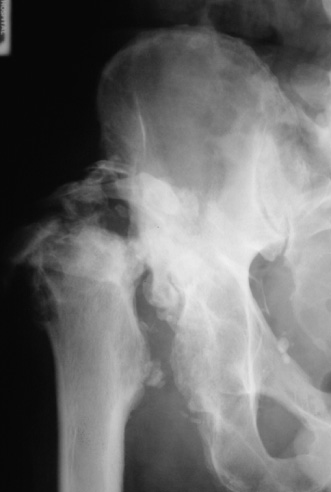
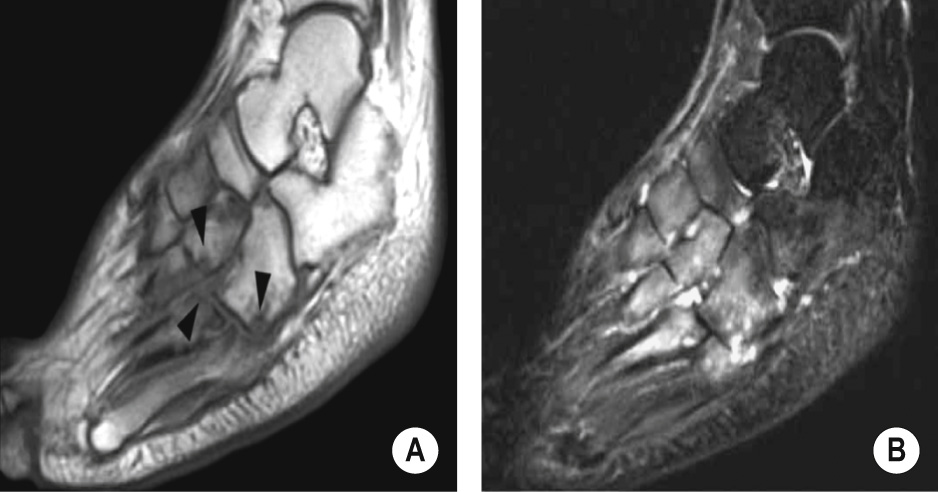
| Condition | Prevalence of arthropathy | Joints most commonly affected |
|---|---|---|
| Congenital insensitivity to pain | 100% | Ankle, tarsal, knee, hip |
| Syringomyelia | 20–50% | Shoulder, elbow, wrist, cervical spine |
| Neurosyphilis | 5–10% | Knee, hip |
| Diabetes mellitus | 1% | Midfoot, forefoot |
| Alcohol related | Rare | Foot |
This is otherwise known as juvenile rheumatoid arthritis or juvenile chronic arthritis
It is an inflammatory disorder of the connective tissues characterized by joint swelling, pain and tenderness affecting ≥ 1 joints for at least 6 weeks in patients who are < 16 years of age
Acute systemic onset type (Still's disease): constitutional symptoms ▸ hepatosplenomegaly ▸ there is little joint involvement
Oligoarthritis: ≤ 4 joints involved during the 1 st 6 months, usually progressing to:
Polyarthritis: ≥ 5 joints involved (both presentations are equally common) ▸ there is often asymmetrical involvement of the peripheral joints
Systemic arthritis: arthritis + a systemic illness ▸ there can also be a psoriatic arthritis and an enthesitis-related arthritis
Knee > wrist ▸ also involved: feet, shoulders, elbows and hips
Soft tissue swelling ▸ synovitis ▸ synovial hyperplasia and pannus formation ▸ a widened joint space (secondary to an effusion) ▸ periarticular osteopenia
Initially there is cartilage preservation
Epiphyseal overgrowth and premature closure of the physis (due to a prolonged synovitis and hyperaemia) ▸ cartilage loss ▸ there is often extensive ankylosis (affecting the CMC and mid-carpal joints) ▸ joint space narrowing
Bone erosions are uncommon
Marked radial head enlargement may be seen ▸ a widened intercondylar notch of the knee ▸ overtubulated diaphyses ▸ enlarged and osteoporotic epiphyses with compression fractures ▸ florid periosteal new bone formation within the phalanges, metacarpals and metatarsals (cf. RA) ▸ enlarged, irregular and squared carpal bones (due to erosion and repair)
Misalignment and subluxation are uncommon
The cervical spine is the most commonly affected region (it is rare within the thoracolumbar spine or sacroiliac joints) ▸ atlantoaxial subluxation is common ▸ compression fractures ▸ scoliosis (with advanced disease)
There can be underdevelopment and block fusion of the vertebral bodies and intervertebral discs (due to disc and apophyseal joint ankylosis which can also mimic Klippel–Feil syndrome)
Rheumatoid factor is positive in 10% of cases
Complications: leg length discrepancy due to growth plate disturbance ▸ contractures ▸ AVN (due to JIA or the resultant steroid therapy)
In some children isolated hip involvement with bilateral protrusio acetabuli has been documented
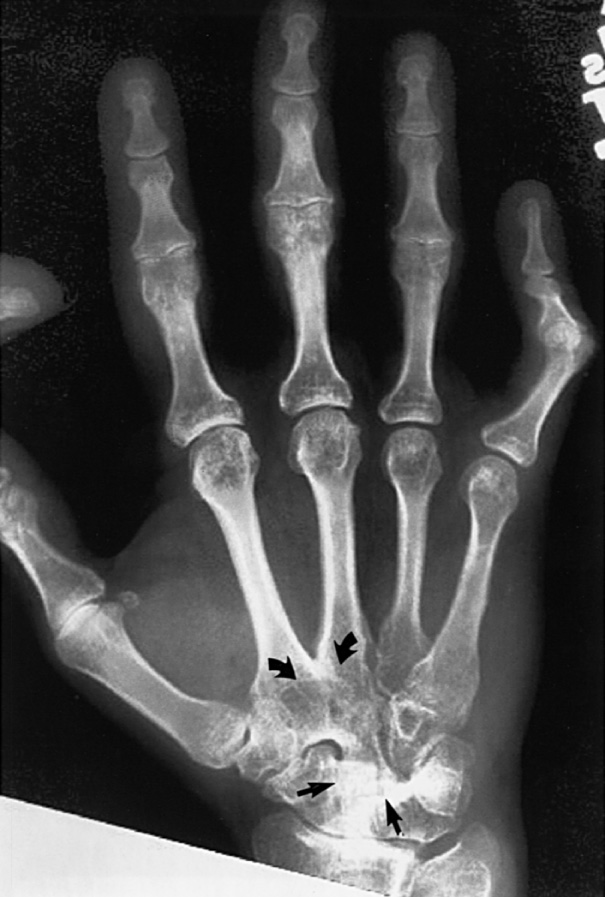
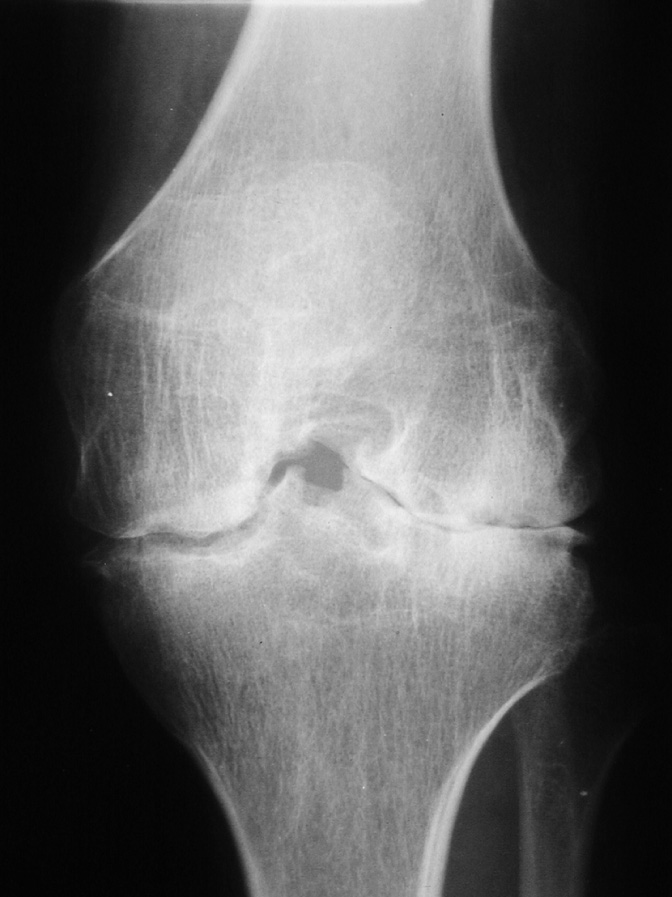
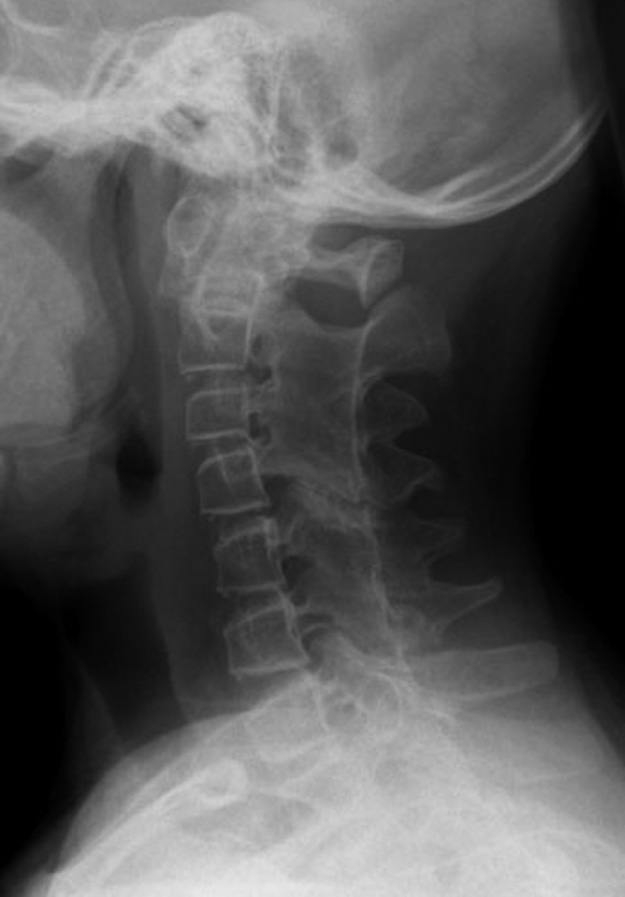
Marked hyperostosis at multiple sites ▸ involvement typically at enthesis sites
A multifocal entity characterized by ‘flowing’ ligamentous spinal ossification involving ≧ 4 contiguous vertebrae with preservation of the underlying disc height (cf. degenerative disc disease)
There is no apophyseal or sacroiliac joint fusion (cf. ankylosing spondylitis) ▸ there is hyperostosis of certain ligamentous attachments
Asymptomatic ▸ back pain and stiffness ▸ tendinosis (commonly affecting the elbow and heel)
T7 to T12 are commonly affected (it is typically right sided as the pulsating aorta inhibits ossification on the left) ▸ ossification of the anterior longitudinal ligament is seen at the affected level (up to 2 cm)
New bone formation within the cervical spine can cause dysphagia
Ossification of the posterior longitudinal ligament can cause spinal stenosis
Enthesopathy: heel and elbow spurs and a whiskered pelvic appearance
Ossification: pelvic tendons and ligaments ▸ superior ![]() of the sacroiliac joints ▸ symphysis pubis ▸ calcaneus ▸ tarsal bones ▸ patella ▸ olecranon ▸ humerus ▸ hands
of the sacroiliac joints ▸ symphysis pubis ▸ calcaneus ▸ tarsal bones ▸ patella ▸ olecranon ▸ humerus ▸ hands
DISH is a reaction to stress and not an arthritis as such

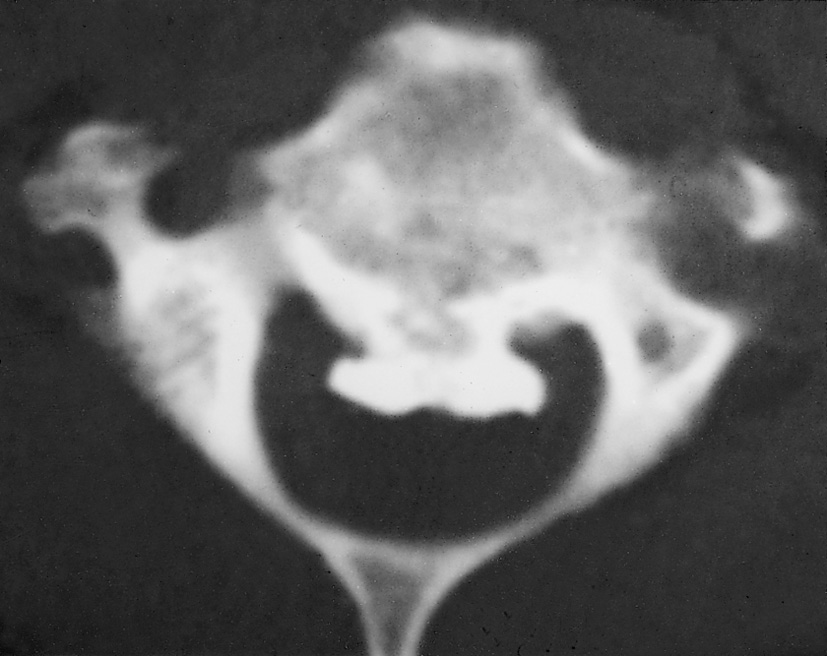
An inflammatory polyarticular synovitis (with synovial hypertrophy) of unknown aetiology ▸ it is a multisystem disease, with a positive rheumatoid factor identified in the majority ▸ joint destruction with late disease
Joint pain ▸ morning stiffness ▸ symmetrical joint swelling ▸ rheumatoid nodules ▸ tendon rupture (F > M)
A symmetrical polyarthritis of the small joints of the hands and feet > larger joints > axial skeleton (usually affecting the cervical spine)
Early: juxta-articular osteopenia ▸ symmetrical soft tissue swelling ▸ joint space widening ▸ tenosynovitis
Later: diffuse osteoporosis ▸ marginal erosions involving the bare area (the bone between the edge of the articular cartilage and the joint capsule attachment) ▸ joint space narrowing ▸ reduced soft tissue swelling ▸ subchondral cysts ▸ joint subluxation and dislocation ▸ joint ankylosis (this is uncommon but typically affects the carpus)
End stage: pancompartmental loss of the joint spaces ▸ resorption of the carpal bones and ‘arthritis mutilans’
Early: periarticular ▸ late: it becomes generalized due to steroid use or limitation of movement
Early widening (due to synovial hypertrophy, effusion or pannus interposition between the articular surfaces) is followed by narrowing (due to cartilage destruction by pannus) ▸ joint alignment abnormalities are caused by tendonitis, tendon rupture or synovitis weakening the capsule
These are classic periarticular marginal erosions involving the ‘bare areas’ of bone ▸ they less commonly involve the larger joints but are often more destructive in nature due to the greater stresses involved
This is less commonly seen than with a seronegative arthropathy ▸ if present it is commoner within the feet
Fusiform swelling (due to capsular distension and oedema) over the IP and MCP joints ▸ swelling over the ulnar styloid (due to local involvement of the extensor carpi ulnaris tendon sheath) ▸ distension of the knee joint capsule (due to lateral displacement of the normally barely visible fat planes adjacent to the distal femur) ▸ rheumatoid nodules
Proximal distribution (carpal/MCP/PIP joints) with sparing of the DIP joints (cf. OA and psoriatic arthritis) ▸ commonly affected sites: the 2 nd and 3 rd MCP joints (initially affecting the radial side – more distal erosions are less commonly seen) ▸ the ulnar and radial styloid processes ▸ the distal radioulnar joint and carpus
Ulnar deviation (due to MCP subluxation)
Volar subluxation and dislocation of the phalanges at the MCP joint
Rotary subluxation of the scaphoid and drift of the entire carpus in an ulnar (± volar) direction
Boutonnière deformity: proximal IP joint flexion and distal IP joint extension
Swan neck deformity: proximal IP joint extension and distal IP joint flexion
‘Telescope’ fingers: phalangeal dislocation with subsequent shortening
Changes lag behind those in the hands ▸ disease initially involves the MTP joints (particularly the 4 th and 5 th ) with erosions on the bare areas of the metatarsal heads ▸ lateral phalangeal subluxation with PIP joint dorsiflexion deformities ▸ bony ankylosis with chronic disease
There is predominantly medial joint involvement (cf. superior joint involvement in OA) ▸ medial migration and acetabular resorption results in protrusio acetabuli
Lateral clavicular resorption ▸ upward subluxation of the humeral head
Disease usually affects the cervical spine (the thoracic and lumbar spine are rarely involved) ▸ cervical spine facet joint erosions may result in subluxation and nerve entrapment ▸ basilar invagination is a late feature
Atlantoaxial subluxation: this is due to cruciate ligament damage (separation in flexion of > 2.5 mm in adults or 5 mm in children is abnormal)
Odontoid erosion: this results from involvement of the synovial joint between the odontoid peg and cruciate ligament or involvement of the small bursa adjacent to the odontoid
Odontoid fracture: this is due due to erosions or osteopenia
Become a Clinical Tree membership for Full access and enjoy Unlimited articles
If you are a member. Log in here